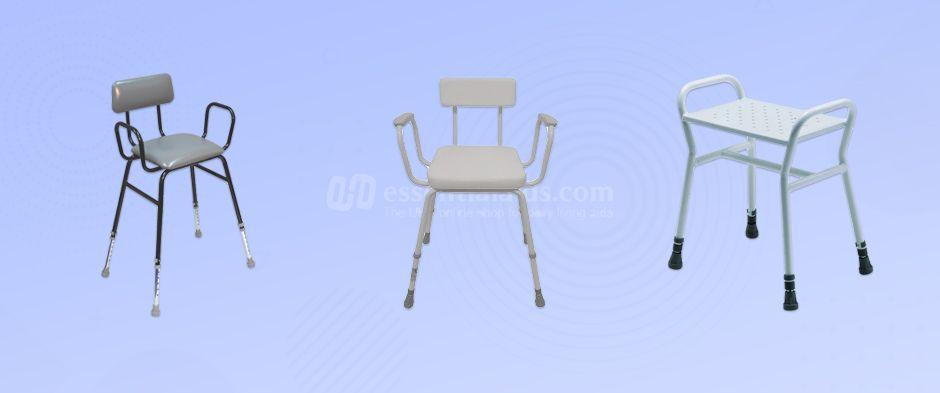
Perching Stools - Life on the Edge
Sally Madeley-Carr, OT12 Mar 2020
Many people in later life find it difficult to stand unsupported for even short periods of time. While there are pieces of equipment like grab rails which can help, these usually require the use of at least one hand in order to maintain support. The advantage of using a perching stool is that it allows you to take weight off your legs while leaving your hands free.
These stools are distinct from conventional stools in that their sitting surface is slightly. Tilted. This creates a gentle slope from back to front, encouraging the user to 'perch' on the leading edge, in a 'semi-standing' position. These stools are much taller than standard stools, so the user can lean their bottom on them at a natural height.Most perching stools are also height adjustable, allowing them to be set at a comfortable height for the user.
The hands are therefore left free to do whatever is required - such as preparing vegetables at a kitchen worktop, or brushing your teeth at the bathroom sink. Among essentialaids.com's kitchen aids is a popular section devoted to high quality perching stools.
Why would you use a perching stool?
Many physical conditions make it hard to stand for sustained periods. Arthritis is a particularly common problem for a lot of people in old age, and it can weaken hip and knee joints, meaning standing for extended periods is painful.
Other conditions which can cause unsteadiness and difficulty in completing tasks when standing include stroke, dementia, brain injuries or multiple sclerosis. .Some conditions cause excessive fatigue, which also makes standing to complete tasks challenging.
This means preparing food at the kitchen worktop or using pots and pans at the hob may become a practical problem. Similarly, using the kitchen sink while washing up may also become difficult.
For some people, moving from a fully seated position into standing can be difficult and very uncomfortable, so preparing food while sat on a kitchen chair at the table may not be as convenient as using the worktop.
So, the challenge here is to provide people with a means of support which doesn't rob them of their immediate mobility or the freedom to use their hands. Simply using a conventional high-chair or stool would not solve the problem for a few important reasons.
Firstly, the seat needs to be at a certain height to allow the user to work effectively at the worktop or sink; standard stools do not adjust to this kind of height. High stools designed for kitchen islands or breakfast bars usually require the user climb up to sit on them, with their feet on a footrest some way above floor level.
For a person with impaired mobility, or balance issues, this is a difficult or even dangerous transfer to undertake - both to get up on to the seat and then to get off it again. There is also a high risk of falling involved in the process..
A perching stool on the other hand provides a means of support but does not require the user to regularly stand up and sit down from a full sitting position. Instead, it takes a large proportion of the user's weight, without requiring much strain or flexibility.
In the semi-sitting position, the person will have their legs only slightly bent, meaning getting up from the perching stool to move around the kitchen is easier..
Once sat on the perching stool, the user can prepare food, wash the dishes or complete any other task required that they would normally. With the weight taken off their legs and feet, any strain on the body is significantly reduced.
This simple tool can make a significant practical improvement in day-to-day living, an incremental step towards maintaining independence in the home.
You might also consider using a perching stool if you are recovering from injury and have difficulty putting your full weight on one or both of your legs for sustained periods. If you're using crutches to get around, for example, a perching stool might be a useful addition.
Where to use a perching stool
As discussed, the traditional place to use perching stools is in the kitchen - they are great for using at worktops and sinks. But as well as being practical kitchen aids, they are also great in the bathroom.
Many people struggle to stand in comfort while using a bathroom sink. While a strategically placed support rail can help, it does require the user to occupy one hand to hold on to it.
Placing a perching stool at the sink is for some people the ideal solution. As in the kitchen, it provides the opportunity to semi-stand while the user brushes their teeth, uses the mirror or washes their hands and face. With both hands free, the user isn't restricted.
Certain perching stools are suitable for use in shower cubicles, but it's important to ensure you choose one with non-corrosive parts, and a seat which drains readily.
Bear in mind that the footprint of this type of stool is usually much larger than standard, so you would need a large cubicle to accommodate one.
Setting the height
Most perching stools are height adjustable. The overall height of the seat is set by extending the length of each leg. On most models, this is done using a simple pin-clip mechanism. By compressing the pin, the lowest shaft can slide inwards or outwards before the pin engages again at the desired increment aperture.
Obviously it is of vital importance that you ensure each of the four legs is extended to the same degree before use and the stool is thoroughly checked for stability.
When sitting on the stool, make sure you set it at such a height which enables you to have both feet flat on the floor with your legs slightly bent when you're sitting on it.
If your legs are too straight, there might be a tendency to press too far backwards against the stool, which would not be safe.
Stability and grip
When using a perching stool a degree of pressure is not just downwards but also backwards. For this reason the stools have splayed legs, improving stability.
With safety in mind, it is also crucial that they aren't prone to sliding on the floor. Bathroom and kitchen floors are often tiled, so each leg of perching stools feature a rubber or plastic foot.
These feet are also known as 'ferrules' - they create high friction contact points which make the stool unlikely to slip. They can be easily replaced if they wear out.
Aluminium perching stools
Aluminium is the ideal material for many mobility and disability aids because of its light weight, rigidity and non-corrosive nature. For perching stools, which will often be used by those with reduced strength, it is perfect.
Because they are often used in bathrooms, aluminium's non-rusting properties are especially welcome.
Perching stools are sometimes made from steel, but this tends to be more for bariatric individuals who require stronger, larger products. The drawback with steel is that it rusts, making it generally unsuitable for bathrooms. It is also much heavier than aluminium, meaning it is more difficult to move and position for those with reduced strength.
Backrest and armrests
In order to keep the weight to a minimum, perching stools without back or armrests are popular choices, but those additional features are great if you're looking for more support.
For people with compromised balance, having extra features like armrests and a backrest may create a more secure feeling.
If you're using the stool to prepare food at a kitchen worktop, you may find armrests allow you to rest your elbows and in turn keep your hands steady. For people with a tremor this can be especially useful.
Armrests can also help with the process of getting up and down from the perching stool. It is important to consider the stability of the stool through this process. While the legs are splayed - which helps keep the stool stable - the user should still concentrate on always applying equal pressure with each hand as they lean down on the armrests.
While perching stools aren't designed to be lent back against like chairs, some people like the sensation of being able to feel the backrest behind them. Essential Aids has a wide range of stools, some with backs and arms and some without.
More than one?
You may find that you need more than just a single perching stool. You may have one next to the bathroom sink and another in the kitchen.
Use in combination with grab rails?
For maximum safety and especially for bathroom use, you might consider fitting a grab rail next to the stool's location. This provides an extra support point when you get on or off the stool, incrementally improving safety.
Other considerations
While perching stools are great pieces of equipment in the fight to remain independent, they do require a certain amount of space. Before choosing one, ensure you have adequate storage room to keep it when not in use.
The padding and material used for the actual seat of the stool is another thing to think about. While most models have a wipe clean surface, some are more padded than others. The same goes for any arms and backrests. If the stool is intended for a shower cubicle, make sure that it's seat is not filled with foam, which may soak up water.
Perching stools are among essentialaids.com's most popular kitchen aids.

Sally Madeley-Carr, OT
Sally qualified as an Occupational Therapist in 1996 and is a well-respected professional in the field of rehabilitation equipment and living aids. She has worked in private practice and within the NHS, developing a broad experience with adults and children. Click here for Sally's registration with the Health and Care Professions Council. The HCPC regulates health, psychological and social work professionals in the UK.